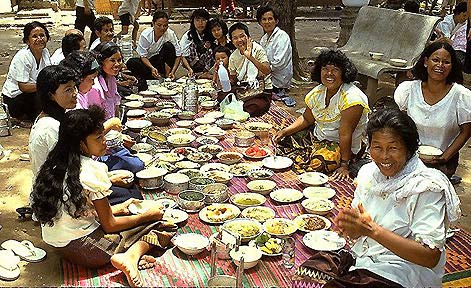The Remaining Right Side of the Buddha
Part 8: Making Plans for Siem Reap
Tuesday - May 25, 1993
By Tuesday, the third day of polling, the mood had changed so dramatically that Jack and I, along with a Dutch friend named Ken
decided it was a good time to go to Siem Reap and see Angkor Wat. We were very excited by this prospect as we had all pretty much
ruled it out as even a remote possibility. After two days of quiet voting the time now felt right.
We each got a bicycle and set out to make arrangements. We would fly to Siem Reap as the train was still too dangerous and we
couldn't get on an UNTAC convoy - we heard about one departing the following day but without press cards they wouldn't allow us
to join. I changed the date of my ticket for Bangkok to give myself a few extra days - I would leave Cambodia the day after the last
day of polling.
At the offices of Kampuchea Air, we signed our names to a list for a one-way flight the following morning. There were only two other
names on the list. We were assured that the plane would fly as scheduled but it was also suggested that we stop back later in the
day to see whether it was canceled. When we did, the list of passengers had grown to ten.
We had lunch at a buddhist temple known as Wat Than where there was a big communal scene with monks and others in solidarity
with peace. Many there had participated in the peace march - a walk that took the participants across 140 miles of Cambodia from
Siem Reap to Phnom Penh.
 We were invited to sit on a patch of grass and were surrounded with a wide variety of foods in which we heartily indulged amidst the
radiating smiles of a dozen Khmer women. We met an interesting young monk who spoke English and had recently been forced,
at gunpoint, to return to Cambodia from the Khao I Dung refugee camp. The UNHCR had recently closed the last of the refugee
camps that had dotted the Thai-Cambodian border and served as home for some 370,000 Cambodians. Many refugees had been
in the camps since the early eighties and associated life in Cambodia with great suffering - they thus objected to the forced
repatriation. We were invited to sit on a patch of grass and were surrounded with a wide variety of foods in which we heartily indulged amidst the
radiating smiles of a dozen Khmer women. We met an interesting young monk who spoke English and had recently been forced,
at gunpoint, to return to Cambodia from the Khao I Dung refugee camp. The UNHCR had recently closed the last of the refugee
camps that had dotted the Thai-Cambodian border and served as home for some 370,000 Cambodians. Many refugees had been
in the camps since the early eighties and associated life in Cambodia with great suffering - they thus objected to the forced
repatriation.
Jack spoke in Thai with a monk who'd come from Thailand to participate in the peace march. As they spoke, Khmer women came
kneeling to the monk's feet, stuffing money in his pockets. The monk had a car but no driver and was trying to recruit us to drive
him to Vietnam. We thought about it for about half a second and respectfully declined saying we had other plans.
Considering that we were about to venture outside of Phnom Penh, we thought it was time to register our presence in the country
with the US mission. At that time, the US had neither an ambassador nor an embassy in Cambodia but they had established a
mission around the time that the UN sponsored peace process had begun.
The US government had been issuing travel advisories against travelling to Cambodia for months. Still the official at the mission had
no reaction whatsoever to our plans to visit Angkor. I guess he figured that if you were already in the country then you knew what
you were up against.
I had a decidedly different reaction later that afternoon at the UN Human Rights office. I stopped by the offices to say goodbye to
the Khmer studies expert I'd met the previous week. This guy knew a few things about Cambodia - he was a PhD candidate in Khmer
culture and history at Oxford, spoke the language fluently, and had been in the country longer than UNTAC. He said we were crazy
to go to Siem Reap elaborating that history had proven the Khmer Rouge capable of just about anything. Theary was also there,
having started her new job, and I said goodbye to her as well. |